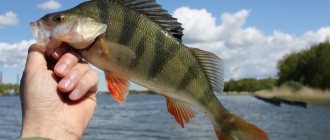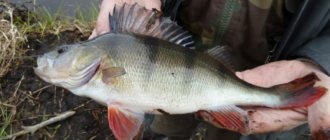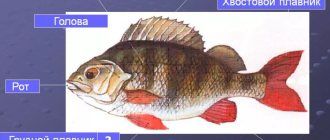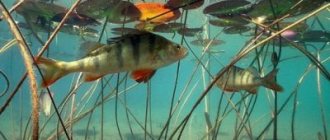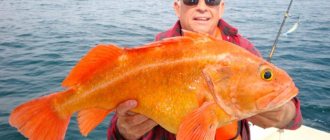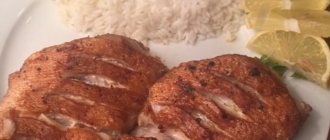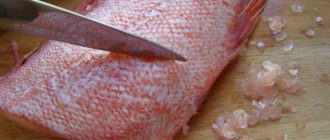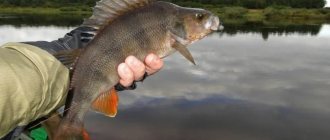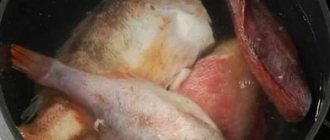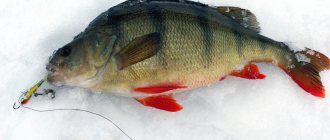Characteristics of Princess of the Nile
Nile perch belongs to the ray-finned fish of the Latidae family of the order Perciformes.
It is the largest perch in the world. Some individuals reach a weight of 200 kg with a length of 2 m. The usual parameters of an adult fish of 15-20 years of age are weight 30-50 kg and size 60-80 cm. Over the course of a year of life, perch gains 3 kg of weight. It is a predator, its diet consists of small fish and crustaceans.
The spawning period lasts from late February to mid-March. The survival rate of eggs is 20%, some of them are eaten by the perch itself, some by other predators, plus the influence of various unfavorable environmental factors.
In African countries it has commercial importance and is an object of fishing tourism.
Where does the giant live?
The habitat of the largest perch in the world is the fresh waters of tropical Africa. Found everywhere on the entire black continent. Large populations of Nile perch live in the following rivers:
- Nile;
- Volta;
- Congo;
- Senegal.
Also found in lakes in Lakes Albert, Victoria, Rudolph, Chad.
Inside reservoirs, fish prefer to be in places of bends and rifts. Selects the most sun-warmed, but at the same time relatively deep (2-3 m) places.
The nutritional value
The taste of giant perch is almost no different from the usual river perch. Valued for its delicate taste and low fat content, it is recommended by nutritionists. The loin and back parts of the fish are considered especially tasty.
Princess of the Nile is boiled, fried, baked, smoked, and dried.
The cost of fresh fish and semi-finished products from it is high. In addition to sales on the domestic African market, it is exported from Egypt and Cameroon to European countries and Russia.
Useful properties of Nile perch
Nile perch is valued for its excellent taste, and therefore has great nutritional value. Its meat is juicy and tender and easy to process. In addition, this type of perch is inexpensive and highly valued by gourmets, so it will decorate the menu of any restaurant.
Typically, Nile perch meat is sold in the form of fillets, with the cheapest pieces being the meat from the peritoneum, and the most expensive being the meat from the back.
Nile perch recipes
Nile perch can be boiled, fried, smoked, but it tastes best when baked in the oven. This way the fish meat will retain its taste and tenderness as much as possible.
Oven-baked Nile perch
Ingredients:
- Perch fillet – 500 grams;
- Vegetable oil – 50 grams;
- Lemon juice;
- Bay leaf, thyme, parsley - 2-3 pieces of each type;
- Salt - to taste.
Cooking steps:
- Salt the fish fillet, then sprinkle it with lemon juice and olive oil;
- Mix with chopped herbs and leave for half an hour;
- Place in an oven preheated to 180 degrees and bake until done.
- Serve with fresh herb leaves. Bon appetit!
Nile perch baked with vegetables
Ingredients:
- Perch fillet – 500 grams;
- Fresh tomatoes – 3 pieces
- Onions – 1 piece;
- Sweet bell pepper – 1 piece;
- Soy sauce – 1 tablespoon;
- Capers – 1 tablespoon;
- Lime – 1 piece;
- Vegetable oil – 1 teaspoon;
- Garlic – three cloves;
- Hard cheese – 50 grams.
Cooking steps:
- Cut the fish fillet, sprinkle with lime or lemon juice and oil, add crushed garlic and leave to marinate;
- Simmer the onion cut into rings until soft, then add the pepper and finely chopped tomatoes. Simmer for 20 minutes;
- Place the fish in a mold, place the stewed vegetables on top and put in the oven for half an hour;
- Sprinkle the top of the dish with grated cheese and bake again for 10 minutes.
- Serve fish with fresh herbs. Bon appetit!
If you are lucky enough to go to the habitats of the Nile perch, do not miss your chance to hunt this giant fish. Fishing is truly exciting; you just need to prepare strong gear and be prepared for a difficult fight with this large predator.
And if fishing is not successful, you can always buy fillets of this fish in a store or try it in a restaurant and enjoy the tasty, tender and juicy meat of the largest perch on earth.
Benefits and harms
With constant consumption of perch meat, sweating decreases, memory improves, and blood pressure normalizes. Thanks to the beneficial properties of meat, you can increase your performance, get rid of depression and skin dermatitis, and maintain a healthy male and female genitourinary system.
Perch meat is enriched with:
- proteins and healthy fats, vitamins B, C, E, D, A and PP;
- macro and microelements: potassium, phosphorus, calcium, iron and zinc.
Freshwater fish dishes can be called dietary; the energy value of 100 grams of perch meat is 82 Kcal. When consuming 150 grams of fish daily, the required amount of amino acids necessary for the body is replenished.
Perches can suffer from almost two dozen diseases. Protozoan and multicellular parasites can infect almost all organs of a creature. The most common disease occurs in which the perch loses coordination, reaction and becomes passive. The fish move chaotically in a spiral, rising to the surface, then descending to the bottom and dying there. Several diseases are especially dangerous for humans: the first is caused by a trematode, the second is caused by a tapeworm. You can become infected with them by eating undercooked or poorly fried fish, as well as poorly salted food. For two months after eating contaminated fish, no symptoms may appear. Then, pain in the abdomen may appear, as well as indigestion. Anemia may also develop. Preventive measures for these diseases are good heat treatment of fish products, as well as thorough salting.
All about fishing for Nile perch
It is difficult to find a fisherman who does not dream of catching such a valuable and large trophy. The giant fish attracts with a special adrenaline in the process of fishing for prey. Many experienced fishermen recommend starting to catch predators in Lake Nasser.
There is a popular destination among travel companies that lay out safari routes through the known habitats of the predator. Not all safaris include fishing, so it is better to check the route and potential catch with travel companies in advance. There are also special tours aimed exclusively at catching this fish.
Giant fish are attracted by the special adrenaline in the process of fishing for prey.Time to catch Nile perch
When choosing a time to fish for Nile perch, experts recommend going on a safari in mid-summer. The predator bites well starting in May, the fishing season lasts until October. Winter fishing turns out to be ineffective, as perch refuses to bite in cold weather. April is also a good time for fishing, but due to the spawning period, the authorities prohibit fishing for the giant.
Successful seasons:
March to June is the best time for shore fishing, now the fish move closer to the shore and become available during fly and spin fishing. It is possible to catch individuals up to 10 kg; from July to August is a season with a stable bite, fishing almost always ends successfully, but you will have to constantly be under the heat, which scares off most fishermen
The positive thing is that the fish are less wary; the season October-December is suitable for trolling fishing. Now shore fishing is ineffective, all the fish are moving away from the shore
Some individuals can also be caught on successful wobblers from the shore.
During the rainy season (from August to October), it is better to refrain from fishing; it is unlikely to please you with your catch.
Lures for fishing for Nile perch
The largest specimens are caught using trolling gear using a large boat. In African waters, you can catch fish from the shore using large, heavy gear.
With the help of a large boat, the largest individuals are caught using trolling gear
Dependence of gear on potential catch:
- heavy gear allows you to catch individuals weighing 35-90 kg;
- for medium-heavy gear – 18-20 kg;
- for light rods – 2-7 kg.
Light tackle should certainly be present in a fishing bag for preparing bait. Small tiger fish weighing up to 1 kg are considered the ideal bait for live bait fishing. The fish willingly go for various wobblers for trolling.
Tactics and fishing techniques
Real fishing for Nile perch is a fascinating, but physically demanding process that requires high-quality preparation
Before you start fishing, it is important to purchase reliable gear adapted to hold huge weights.
When buying fishing line, you should pay attention exclusively to thick and durable options.
There are 2 main ways to catch a predator: spinning and trolling. Spinning fishing makes sense from the shore, but you need to choose the right season and from a large boat. Fishing on small boats is unsuccessful; if caught, the fish overturns the boat.
How does a fish behave when fishing?
The representative of perch is an exclusively predatory fish, which often survives other species of predators and peaceful fish inhabiting the reservoir. The fisherman will certainly have memories that will last a lifetime if he manages to get a bite from a large specimen. The difficulty of landing is associated not only with the large size of the predator, but also with the desperate struggle after the hook. Often the fisherman has to fight the fish for a long time himself, exhausted under the scorching rays of the sun.
You can only get a trophy for your collection if you have experience, a high level of physical strength and dexterity. Often a perch breaks the tackle and leaves the fisherman intact.
Originally posted 2018-09-10 16:26:15.
Description and structural features
In appearance, Nile perch is closer to pike perch than to perch. The Nile perch belongs to the Latidae family, belongs to the class of ray-finned fish and is perhaps the largest freshwater fish.
This truly gigantic fish has a flattened head, which is slightly extended forward. The fins of the Nile perch are rounded. Individuals of the Nile perch have silvery scales with a blue tint. However, the color can sometimes be of other colors, various combinations, for example: green-yellow, lilac, gray. The eyes of the Nile perch are dark in color, while around the pupil they are bright yellow.
These individuals have two distinct fins on their backs, one of which is pointed. Those who have seen Nile perch jumping over the water note that this is a truly mesmerizing sight.
Sizes of individuals
This largest representative of perches in the world reaches a length of two meters and a mass of about 150-200 kilograms. By the time this fish reaches the age of 15 years, its weight already exceeds 30 kilograms. Therefore, the Nile perch is called the largest freshwater fish in the world. Its gigantic size means that individuals of this fish are dominant in their habitat.
Interestingly, the Nile perch hatches its fry in the cavity of its mouth, which gives them a greater chance of survival. The diet of the Nile perch is mainly crustaceans, insects, and small fish. Some individuals of this giant fish are suspected of cannibalism (primarily drowned people), but there is no confirmed data on this.
We suggest you familiarize yourself with: The best pvc boats
Description of Nile perch
In shape, the Nile perch more closely resembles a pike perch than a perch. They ranked it among the genus Latidae, which, for their part, represent a class of ray-finned fish. Nile perch is perhaps the largest freshwater fish, despite the fact that there are other equally large representatives of freshwater bodies.
This is a truly large fish with a flattened head, easily pushed forward. For the most part, the fins of the Nile perch have an unusual round shape. The color of the Nile perch is characterized as silver with a blue tint. Ignoring this, individuals are seen with a different color, for example, green-yellow-lilac-gray. The eyes of the Nile perch are more black in color, and within the pupil itself there is a bright yellow edging.
In the area of the back of the Nile giant there are two fins, one of which has a sharper shape. When this fish jumps out of the water, it is truly a unique sight.
What size does it grow to?
This freshwater giant grows up to 2 meters in length, or even more, with a weight of 150 to 200 kilograms. At the end of 15 years of life, the Nile perch already gains a weight of 30 kilograms, based on this, it was ranked among the largest freshwater fish. Due to the fact that this fish is able to grow to such a size, the Nile perch is constantly the main species. Also, do not forget that this fish is predatory.
Interesting fact! The Nile perch breeds its offspring in its own mouth cavity, giving it a much better chance of survival while under the constant protection of its parent.
The diet of the Nile perch consists of living organisms, such as crustaceans and insects, and small fish. There are some statements indicating cannibalism (mostly drowned people), despite the fact that such facts have no evidence, otherwise, why not.
Where does he live?
Nile perch can live both in natural reservoirs and in artificially created reservoirs.
In nature
This fish is distributed mainly in Africa, in rivers such as the Nile, Congo, Volta and Senegal. It is also possible to meet it in lakes Chad, Victoria, Albert and others where drinking water is noted. This fact shows that this fish is heat-loving and does not spread to water bodies far from southern latitudes.
Unnatural bodies of water
Nile perch is grown in artificially created reservoirs, but the grown individuals differ sharply in size from their relatives developing in their natural habitat. There are many similar artificially created reservoirs in the world. This is due to the fact that this fish is quite healthy and is used for making various dishes, as well as haute cuisine.
Necessary properties of Nile perch
Nile perch has been valued since ancient times due to its beautiful taste. The meat of this fish is juicy and tender, at the same time it is easy to prepare and has no bones. Also, its meat is not expensive, but therefore affordable and can decorate any table, not necessarily a festive one.
In most cases, Nile perch meat is sold in the form of fillets, along with this, not expensive pieces of fillet are meat from the abdominal cavity, and more expensive pieces are from the back.
Description of Nile perch
In shape, the Nile perch more closely resembles a pike perch than a perch. They assigned it to the genus Latidae, which, in turn, represent the class of ray-finned fish. Nile perch is perhaps the largest freshwater fish, although other, no less large representatives of freshwater bodies of water are known.
This is a truly large fish with a flattened head, slightly pushed forward. Basically, the fins of the Nile perch are distinguished by their peculiar rounded shape. The color of the Nile perch is characterized as silver with a blue tint. Despite this, there are individuals with other colors, for example, green-yellow-lilac-gray. The eyes of the Nile perch are more of a dark shade, and within the pupil itself there is a bright yellow edging.
In the area of the back of the Nile giant there are two fins, one of which has a sharper shape. When this fish jumps out of the water, it is truly a unique sight.
What size does it grow to?
This freshwater giant grows up to 2 meters in length, or even more, with a weight of 150 to 200 kilograms. After 15 years of life, the Nile perch already gains a weight of 30 kilograms, which is why it is ranked among the largest freshwater fish. Because this fish is able to grow to such a size, the Nile perch is always the dominant species. In addition, it should be remembered that this fish is predatory.
Interesting fact! The Nile perch breeds its young in its mouth cavity, giving it a much better chance of survival while under the constant protection of its parent.
The Nile perch's diet consists of living organisms such as crustaceans and insects, as well as small fish. There are some statements pointing to cannibalism (mostly drowned people), although such facts do not have any evidence, but on the other hand, why not.
Sizes of individuals
This largest representative of perches in the world reaches a length of two meters and a mass of about 150-200 kilograms. By the time this fish reaches the age of 15 years, its weight already exceeds 30 kilograms. Therefore, the Nile perch is called the largest freshwater fish in the world. Its gigantic size means that individuals of this fish are dominant in their habitat.
Interestingly, the Nile perch hatches its fry in the cavity of its mouth, which gives them a greater chance of survival. The diet of the Nile perch is mainly crustaceans, insects, and small fish. Some individuals of this giant fish are suspected of cannibalism (primarily drowned people), but there is no confirmed data on this.
Where does he live?
Nile perch can live both in natural reservoirs and in artificially created reservoirs.
In nature
This fish is distributed mainly in Africa, in rivers such as the Nile, Congo, Volta and Senegal. It is also possible to meet it in lakes Chad, Victoria, Albert and others where drinking water is noted. This fact shows that this fish is heat-loving and does not spread to water bodies far from southern latitudes.
Unnatural bodies of water
Nile perch is grown in artificially created reservoirs, but the grown individuals differ sharply in size from their relatives developing in their natural habitat. There are many similar artificially created reservoirs in the world. This is due to the fact that this fish is quite healthy and is used for making various dishes, as well as haute cuisine.
Nile perch is a real predator
The Nile perch has a very powerful fin on its back, which is a real weapon and protection for the fish. This giant fish is a fierce predator and eats huge amounts of food. Food can be a completely diverse prey: from crustaceans, mollusks and insects, ending with fish and even individuals of their own species.
It was often noticed how Nile perch ate its own brothers, and Africans have rumors that this fish will not disdain even human meat. However, fortunately, there is no evidence that Nile perch does not disdain human flesh. In addition, the Nile perch is the largest predator of Lake Victoria.
Nile perch (Lates niloticus) is one of the most valuable products and fisheries on the African continent. It was grown by the ancient Egyptians in special ponds at least 4000 years ago. A female Nile perch is capable of producing at least 16 million eggs in one year.
Nutrition
From a biological point of view, perch is an omnivorous type. The diet, according to the community of biologists, consists of small fish, tadpoles and other organic food, which classifies it as a predatory fish species. But this is partially not true. Yes, large individuals of perch are sometimes able to feed even on crustaceans, but the majority are able to consume the eggs of other fish, worms, insects and even plant parts of food.
But fishermen persistently consider it a predator of fresh waters. Science has proven that the individual is very voracious. Constantly hungry and on the move. It feeds on everything that moves. Researchers found small bottom pebbles and algae inside some predators. The constant desire to eat fills him with energy and speed.
Summarizing the data on the diet of the predatory robber, we highlight its main food in fresh water:
- small fish of other species (theirs or even their own young - roach or similar)
- caviar of neighbors in the pond;
- mollusks (if present in the habitat);
- various insects and their larvae;
- aquatic worms.
Sea bass is a predatory species. Its food is considered to be marine invertebrate organisms - mollusks, or plankton. Successfully consumes the eggs of other sea inhabitants. Can eat plant foods – algae. Behavior is similar to the river species. Equally energy-intensive and constantly hungry. Large individuals are able to hunt for prey, hiding in algae thickets, unexpectedly attacking potential food.
Habitat
The native places of nilus are in the freshwater bodies of the black continent - the Senegal, Nile, and Volta rivers. Congo, in lakes Rudolph, Albert, Rudolph, Tana. This fact suggests that the fish is thermophilic and does not spread far from southern latitudes.
The most numerous perches are in Lake Victoria, located almost on the equator, where the fry of this predatory fish were introduced in 1962. Soon they multiplied, beginning to actively displace the local aquafauna, upsetting the natural balance.
Reference. Victoria is the second largest freshwater lake in the world. The Nile River originates from here.
Adult individuals of nilus have mastered depths from 10 to 60 m in rivers and reservoirs, the waters of which contain the amount of oxygen necessary for comfortable living.
They eat everything and a lot, increasing the number and size of food objects with age. Largemouth adults feed primarily on crustaceans, insects and small fish, including their own relatives. When examining the stomach contents of medium- and large-sized perches, the remains of small counterparts were discovered.
The main prey of juveniles is shrimp and shellfish. Growing up, perch fry, juvenile predators, gather in small schools and begin to hunt together and aggressively.
According to ichthyologists, the introduction of fry into Lake Victoria had a negative impact on the number of other fish species. More than 200 species of cichlids that innocently feed on algae have completely disappeared and are on the verge of extinction. As a result, the reservoir is gradually overgrown with vegetation.
Nilus has practically no enemies - only people. Even Nile crocodiles, the second largest on the planet, do not risk messing with them. Probably afraid of choking (just kidding).
Legend. Lake Victoria has its own Nessie. The aborigines claim that a mysterious creature with a square muzzle lives in a deep reservoir - a lukvata. The animal sometimes chases pies with fishermen, trying to knock them over. White travelers also saw and confirmed this version. There is a suspicion that this is some kind of huge, elusive specimen of Lates niloticus.
Fish Bass
Largemouth bass, which belongs to the genus black perch, is often called trout perch or bass (in English, perch is “bass”). The homeland of this species of fish is considered to be the waters of North America, but largemouth bass is often found in the basins of the Atlantic and Pacific oceans, the Black and Mediterranean seas.
Appearance
Bass can be recognized by its olive-green body color, covered with dark spots that form a jagged horizontal stripe on the sides of the fish. The body of this fish is elongated, and with age it is strongly compressed on the sides. The head of a largemouth bass is relatively large, and the upper jaw on it extends much further than the eyes. There are more than 60 ctenoid scales along the lateral line of the body, and a deep groove separates the dorsal fin. Bass fish are one of the largest members of the black grouper family and can reach up to a meter in length and weigh more than 10 kilograms. Females are much larger than males.
Habitat
Largemouth bass prefer to live in quiet and calm waters, where the bottom topography and vegetation allow them to hide and wait for prey. Nature created such conditions in the east of the Rocky Mountains in the USA, where bass have lived for a long time. This fish has also taken root in the reservoirs of Portugal, Spain, Croatia, and Italy, where it was successfully acclimatized. Largemouth bass can also be found near Cyprus and the Japanese Islands. Recently, its population has increased in water bodies of China, Vietnam and Korea.
Attempts to acclimatize bass in the reservoirs of our country were less successful, but small populations of this fish (though not of interest for sport and industrial fishing) remained in the Don and Kuban rivers, and in Lake Abrau. The average lifespan of individuals of this fish species is about 16 years.
The spawning period for bass lasts from March to July, when males prepare a nest on a pebble or sandy bottom, and females lay from a thousand to 4 thousand eggs. Each of the males, having fertilized the eggs laid by the females, guards the nest until small fish appear.
Nutritional Features
Despite such care for its offspring, largemouth bass is an ardent predator that does not disdain small species and fry of other fish. At the same time, young bass feed on small fish, insects, shrimp, amphipods, and older fish feed on snails, frogs, crayfish, small fish, salamanders, snakes, bats, small waterfowl and even young crocodiles.
Where, how and when to catch bass
Largemouth bass are a coveted trophy for fishermen around the world. Bass fishing is especially popular in North America, but recently professional and amateur fishermen in European countries and Japan have been trying to outwit this fish.
Professional and amateur fishermen value bass as one of the strongest and most persistent “game fish.” With its resistance, tenacity and power, largemouth bass can compete with salmon. The fish attacks the bait, jumping out of cover with lightning speed and swallowing it whole. Having swallowed the hook, the bass violently resists, then jumps out of the water, then goes into the depths. The self-preservation instinct of largemouth bass is so developed that it often emerges victorious in competition even with venerable and experienced fishermen.
By analogy with its relative, the European perch, largemouth bass is caught using a worm (live and artificial) and live bait. Depending on the natural conditions of a particular reservoir, the appropriate bait is selected. For example, in grassy shallow waters, the easiest ways to catch bass are with poppers, spinner baits, and wobble-free spinnerbaits. Near the shoreline and under overhanging trees, spinners, crankbaits, and light jigs work well to catch largemouth bass. But in snags it is best to use light gliding baits made of silicone, imitating live crayfish, insects and their larvae. At great depths, the most preferred method for catching bass is jig spinning using the so-called “Texas rig.”
Largemouth bass are typically caught during the open water period, from early spring (after the ice has broken up) until the first frost. You can try your luck in open water in winter, but in cold water the bass is less active, the fish requires very delicate baits, and the retrieve must be very slow. In warm water, largemouth bass are more active and the bites are regular and powerful. Largemouth bass, unlike other types of perch, are not caught from under the ice in winter.
Description of the species
The fish has many names, all related to the Nile River (Lates niloticus) - nesihat nilus, Nile perch, water elephant, princess of the Nile. Cave paintings from Ancient Egypt depict people carrying huge fish. They were revered as sacred animals; even the ruins of a necropolis with burials of mummies were preserved.
The weight and dimensions of the Nile perch are much greater than those of other representatives of the perch family. The largest specimen caught in the world weighs 200 kg and reaches a length of 2 m.
For comparison: in Russia, the largest river perch weighing 5.9 kg was caught in the Tyumen region in 1996. And the maximum age of a perch 104 cm long and weighing 17 kg, caught off the coast of Alaska, was estimated by experts to be 200 years.
The appearance of the giant perch can be judged by many photos on the Internet, where happy fishermen can hardly hold their precious catch in their hands.
River monsters living in the territory of fresh and slightly salty lakes and rivers command respect. Beautiful in any plumage - the elongated body is covered with dense scales with a bluish tint, greenish-yellow or lilac, depending on the habitat.
On a flattened, slightly elongated head, dark eyes are set wide with a bright yellow color around the pupil. The lower jaw protrudes slightly forward.
The two dorsal fins - one sharp, the other rounded - have spiny rays, a distinctive feature of the ray-finned class of the Latidae family.
Interesting fact! The largest perch have no bones except dorsal cartilage and sharp teeth.
Choosing tackle
Rod
The most significant element of float gear is, of course, the rod. And here everything is quite simple! Typically, a telescopic rod is used to catch perch with live bait. The telescopic rod is very convenient for transportation. And in the case of float fishing, you don’t need the same sensitivity of the gear as when fishing with a spinning rod. So you can use a plug rod, but it’s not as convenient.
The rod test should be selected based on the weight of the intended equipment. Typically, a rod for catching striped robber with live bait has a test weight of 5 to 30 grams. It is quite natural that when catching small sailors you need to use a light fishing rod. But if you know the place where real monsters live, then you should choose a fishing rod that is heavy enough.
The rod structure does not play a big role when float fishing for perch. But it’s better to fish for perch with a soft rod with a slow action. Perch has very delicate lips, and therefore they can easily be torn when fishing. A rod with a slow action prevents this and makes it possible to bring the perch into the landing net.
Coil
As for the coil, there are also no clear requirements. If you don’t need long casting, you can also use an inertial reel. But in general, of course, the most convenient would be to use a conventional spinning reel. When fishing with a float rod, you don’t have to constantly hold the power in your hands, and therefore the weight of the gear is not so important. So you can use the reel with both front and rear clutch brakes. Here the fisherman must focus on his subjective experience and his preferences. The brake must always be accurately adjusted. Again, the lips of the perch come into play, which very often tear when fishing. It is best to use a 2000-3000 size reel. It allows you to have a sufficient supply of fishing line on the spool and allows you to easily get even large fish out of the water.
Float
The float in the case of catching a striped predator with live bait should have a spindle-shaped or spherical shape. This shape of the float prevents all the attempts of the baitfish to hide in the water column. Therefore, the live bait remains at a given depth, and the perch bite is clearly visible. Do not be afraid that the perch may feel the resistance of the float and spit out the bait. In practice, the striped fish simply has remarkable greed, and therefore it almost never lets live bait out of its mouth. If you hook immediately after the bite, the perch will almost certainly sit on the hook. Although some anglers prefer to wait a fairly long pause for the perch to deeply swallow the bait. In this case, there will definitely be no escape, but it is unlikely that the perch will remain alive after you remove it from the hook. The damage will no longer be compatible with life.
fishing line
As for fishing line, braided cord should be completely abandoned. Firstly, braided line will easily be tangled by baitfish. In this case, the fisherman will not receive pleasure from fishing, but a headache associated with unraveling the equipment. Secondly, monofilament fishing line stretches when fished. We already said above that perch has delicate lips. And thanks to this very stretching, the fishing line serves as an additional shock absorber
This is especially important in cases where a beginner is fishing and cannot yet properly adjust the friction brake of the reel.
The diameter of the monofilament fishing line for perch fishing should be between 0.17 and 0.25 mm. But you shouldn’t rely too much on the fearlessness of the perch either. The diameter of the line should be reasonable. Therefore, it is better to choose transparent fishing line. Since the perch will not see it when biting. In general, when catching a striped predator, you should install fluorocarbon leashes. Usually the perch stays in almost the same places as the pike. So, if something happens, a fluorocarbon leash will help even bring a pike ashore. While a leash made of a simple monofilament line is guaranteed to be cut off by sharp pike teeth.
Hook and sinker
As for the sinker, it is better to use an olive or a shot. Moreover, with the help of pellets you can very quickly change the gear settings. But as for the hook, it is better to choose the hook whose tip is shifted away from the fore-end line. A hook with an offset tip hooks fish much better than all other hooks.
